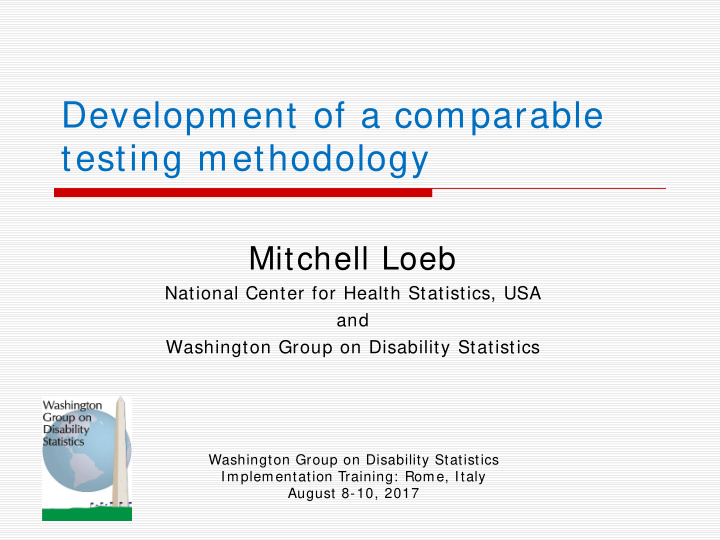



Development of a comparable testing methodology Mitchell Loeb National Center for Health Statistics, USA and Washington Group on Disability Statistics Washington Group on Disability Statistics Implementation Training: Rome, Italy August 8-10, 2017
Goals for Question Evaluation: • How do the respondents understand the survey question? • Do respondents understand the survey question differently? • Does the question mean the same in all the languages that it is asked? • Does the question mean the same in all culture and socio-economic groups that it is asked? • In processing a question, do all respondents recall information and form an answer the same way?
Goals for Question Evaluation: • To what extent are the data elicited from the question a true representation of the phenomena being studied? • In what ways is our picture distorted because the questions do not accurately capture the intended construct? • What important discovery are we not making because we are unaware that our picture is distorted?
Why Question Evaluation? 1. To fix problems 2. Ensure comparability 3. Documentation • Development and evaluation process • “What the question captures” • How resulting data should be used • “Road map” for including question on other surveys, in other languages, in other socio- cultural contexts
Question Evaluation Principles 1. The best question design is based on question evaluation, not expert opinion 2. Question evaluation is science-based • Empirical Evidence • Transparent and Systematic analysis (Qnotes) 3. Evaluation studies must be well documented, replicable, and made accessible (Qbank)
Question Response Process Social Factors Social Factors Social Factors Retrieval Judgment Response Comprehension Social Factors Social Factors Social Factors Social Factors
The Cognitive Test Approach • Cognitive interviews are semi-structured. • The approach adopted is a mix of think-aloud and verbal probing based on a common testing protocol. • Probes are open-ended, not pre-scripted, and spontaneous - based on the information provided by the respondent. Some suggested probes: • How did you come up with this answer? • Why did you answered in that way? • What were you thinking? • Can you tell me more about that? • What do you mean by that? 9/ 7/ 2017 7
Overall, during the past 4 weeks, how much difficulty did you have with thinking clearly and solving daily problems? Respondent 2 Respondent 1 Alzheimer’s Busy disease Long term, Remembering Respondent 3 medical Respondent 6 detailed list problem Specific experience- Fiscal organizing functioning tenants Respondent 5 Respondent 4
Cognitive Testing Findings Child disability questions perform differently than adult disability questions due to: • Parent proxy • Parent’s knowledge of “what is normal” for children of the same age • Relationship between parent and child • Parental frustration with child 9/ 7/ 2017 9
Cognitive testing: An Example Hearing domain Round # 1 D OES [ NAME ] HAVE DIFFICULTY HEARING ? • This question is intended to focus on auditory hearing: that is, the physical capability of the child to hear. • Many respondents, however, focused on listening: “my child doesn’t listen to me when I’m speaking”.
Cognitive testing: An Example Hearing domain Round # 2 D OES [ NAME ] HAVE DIFFICULTY HEARING SOUNDS LIKE PEOPLES ’ VOICES OR MUSIC ?
Cognitive Testing An example: Visual representation of themes that emerged from cognitive interviewing on the self-care question. 9/ 7/ 2017 12
Compared with children of the same age, does [ name] have difficulty with self-care such as feeding or dressing him/ herself? Activities Considered by Respondent General Both Feeding and Only Feeding Only Dressing Conceptualization Dressing Physical capability of Physical capability of Physical capability of child to feed and dress child to feed themselves child to put on clothes Physical capability of themselves child to do a combination of multiple activities including feeding, dressing, bathing, combing hair, Willingness of child to getting in and out of Willingness of child to wear appropriate Willingness of child to bed eat what he/she is clothing eat what he/she is given given; whether child is coupled with the a “fussy” eater willingness of child to wear appropriate clothing 9/ 7/ 2017 13
Discussion
Recommend
More recommend